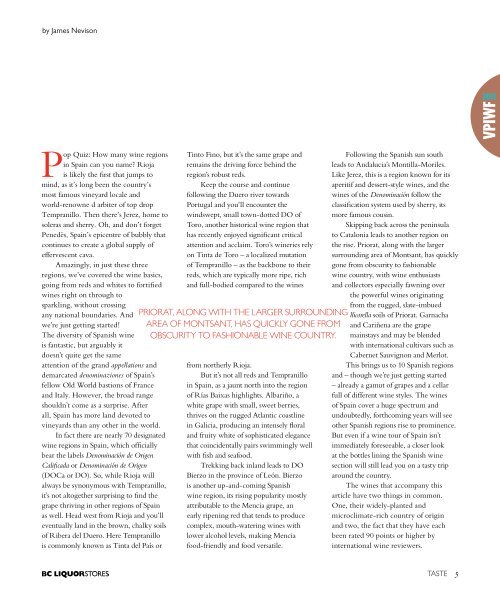You also want an ePaper? Increase the reach of your titles
YUMPU automatically turns print PDFs into web optimized ePapers that Google loves.
y James Nevison<br />
Pop Quiz: How many wine regions<br />
in Spain can you name? Rioja<br />
is likely the first that jumps to<br />
mind, as it’s long been the country’s<br />
most famous vineyard locale and<br />
world-renowne d arbiter of top drop<br />
Tempranillo. Then there’s Jerez, home to<br />
soleras and sherry. Oh, and don’t forget<br />
Penedès, Spain’s epicentre of bubbly that<br />
continues to create a global supply of<br />
effervescent cava.<br />
Amazingly, in just these three<br />
regions, we’ve covered the wine basics,<br />
going from reds and whites to fortified<br />
wines right on through to<br />
sparkling, without crossing<br />
any national boundaries. And<br />
we’re just getting started!<br />
The diversity of Spanish wine<br />
is fantastic, but arguably it<br />
doesn’t quite get the same<br />
attention of the grand appellations and<br />
demarcated denominaziones of Spain’s<br />
fellow Old World bastions of France<br />
and Italy. However, the broad range<br />
shouldn’t come as a surprise. After<br />
all, Spain has more land devoted to<br />
vineyards than any other in the world.<br />
In fact there are nearly 70 designated<br />
wine regions in Spain, which officially<br />
bear the labels Denominación de Origen<br />
Calificada or Denominación de Origen<br />
(DOCa or DO). So, while Rioja will<br />
always be synonymous with Tempranillo,<br />
it’s not altogether surprising to find the<br />
grape thriving in other regions of Spain<br />
as well. Head west from Rioja and you’ll<br />
eventually land in the brown, chalky soils<br />
of Ribera del Duero. Here Tempranillo<br />
is commonly known as Tinta del País or<br />
Tinto Fino, but it’s the same grape and<br />
remains the driving force behind the<br />
region’s robust reds.<br />
Keep the course and continue<br />
following the Duero river towards<br />
Portugal and you’ll encounter the<br />
windswept, small town-dotted DO of<br />
Toro, another historical wine region that<br />
has recently enjoyed significant critical<br />
attention and acclaim. Toro’s wineries rely<br />
on Tinta de Toro – a localized mutation<br />
of Tempranillo – as the backbone to their<br />
reds, which are typically more ripe, rich<br />
and full-bodied compared to the wines<br />
PriorAT, ALonG WiTH THE LArGEr SurrounDinG<br />
ArEA oF MonTSAnT, HAS quiCKLy GonE FroM<br />
obSCuriTy To FASHionAbLE WinE CounTry.<br />
from northerly Rioja.<br />
But it’s not all reds and Tempranillo<br />
in Spain, as a jaunt north into the region<br />
of Rías Baixas highlights. Albariño, a<br />
white grape with small, sweet berries,<br />
thrives on the rugged Atlantic coastline<br />
in Galicia, producing an intensely floral<br />
and fruity white of sophisticated elegance<br />
that coincidentally pairs swimmingly well<br />
with fish and seafood.<br />
Trekking back inland leads to DO<br />
Bierzo in the province of León. Bierzo<br />
is another up-and-coming Spanish<br />
wine region, its rising popularity mostly<br />
attributable to the Mencia grape, an<br />
early ripening red that tends to produce<br />
complex, mouth-watering wines with<br />
lower alcohol levels, making Mencia<br />
food-friendly and food versatile.<br />
Following the Spanish sun south<br />
leads to Andalucia’s Montilla-Moriles.<br />
Like Jerez, this is a region known for its<br />
aperitif and dessert-style wines, and the<br />
wines of the Denominación follow the<br />
classification system used by sherry, its<br />
more famous cousin.<br />
Skipping back across the peninsula<br />
to Catalonia leads to another region on<br />
the rise. Priorat, along with the larger<br />
surrounding area of Montsant, has quickly<br />
gone from obscurity to fashionable<br />
wine country, with wine enthusiasts<br />
and collectors especially fawning over<br />
the powerful wines originating<br />
from the rugged, slate-imbued<br />
llicorella soils of Priorat. Garnacha<br />
and Cariñena are the grape<br />
mainstays and may be blended<br />
with international cultivars such as<br />
Cabernet Sauvignon and Merlot.<br />
This brings us to 10 Spanish regions<br />
and – though we’re just getting started<br />
– already a gamut of grapes and a cellar<br />
full of different wine styles. The wines<br />
of Spain cover a huge spectrum and<br />
undoubtedly, forthcoming years will see<br />
other Spanish regions rise to prominence.<br />
But even if a wine tour of Spain isn’t<br />
immediately foreseeable, a closer look<br />
at the bottles lining the Spanish wine<br />
section will still lead you on a tasty trip<br />
around the country.<br />
The wines that accompany this<br />
article have two things in common.<br />
One, their widely-planted and<br />
microclimate-rich country of origin<br />
and two, the fact that they have each<br />
been rated 90 points or higher by<br />
international wine reviewers.<br />
TASTE 5<br />
2011<br />
VPIWF





